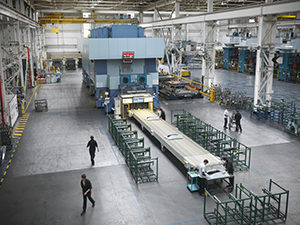Enterprises, regardless of the industry they represent, have become more reliant on mobile technology, which now operates many facets of businesses, with the help of the Internet of Things and wireless LAN. The explosion and combination of IoT connected devices, high performance wireless LAN infrastructure and workforce software is optimizing how employees work inside and outside its four walls.

According to Gartner, by 2020 over 21 Billion IoT devices will be deployed worldwide. Mobile workforce solutions have, in a sense created “virtual workspaces” – multiple business processes, tasks and databases, integrated and accessible in the palm of one’s hand, or from any Internet ready device.
These types of system integrations into daily workflows are happening in practically every operation and at every level within an organization’s chain of command. Plant operators on manufacturing shop floors collect analytics on performance in motion as they work on the production line, without giving any special attention to gathering data. With automation behind their efforts to send all information up the manager flagpole, supervisors to the c-suite get full visibility on the vitality of the entire production process, often with stunning wireless enterprise dashboards. That’s just one example. Supply chain teams are constantly invested in process improvement strategies; when a better way of updating inventory counts is needed, there is no shortage of solutions on the market. The question for decision makers becomes not “how” but “how deep” do you want your data to go? How much visibility and detail do you want when it comes to unlocking the whole story behind inventory, shipping and receiving?
 At the heart of it all, a wireless LAN infrastructure has to shoulder the weight of the enterprise’s entire business, with real-time efficiency. When it comes to quality management and lean operations, today’s decision maker is thinking less about their physical building and resource limitations and are focusing more on how enterprise mobility solutions and wireless networks can get the most out of the resources they do have.
At the heart of it all, a wireless LAN infrastructure has to shoulder the weight of the enterprise’s entire business, with real-time efficiency. When it comes to quality management and lean operations, today’s decision maker is thinking less about their physical building and resource limitations and are focusing more on how enterprise mobility solutions and wireless networks can get the most out of the resources they do have.
There isn’t a company or worksite today that can go without wireless connectivity completely, and if so, the number of these examples shrink with everyday. But, how do you know when your current wireless network and infrastructure is lacking and a refresh is required? Moreover, how can you tell when wireless LAN upgrades become mission critical to growing your business and staying competitive?
 But the BIGGEST question, you have to ask: Is your network ready to handle the volume of demands from IoT devices?
But the BIGGEST question, you have to ask: Is your network ready to handle the volume of demands from IoT devices?
Here are 5 points to note when upgrading a wireless network is necessary to continue:
Your wireless network performance is “less than stellar”
The most obvious reason to refresh a network is that your operations are being held back by a WLAN system that isn’t keeping up with the speed at which you and your employees work. Or, your network can’t keep up with how fast you’re introducing new devices. Think of it in an offline sense; if you’re falling behind with orders due to shipping and other logistics reasons, the same can be said if wireless networks are to blame for revenue generating activities not firing on all cylinders. You’re leaving money on the table. When this happens, however it’s best to work with experts dedicated to the craft of wireless LAN installation to diagnose exactly what your root issues may be. Typically, a site survey will identify dead spots, hardware failures and problems that may even be linked to the physical building infrastructure that will need to be considered. You may find that nothing is wrong at all with the hardware, such as access points or controllers at all, but rather their configuration or location is causing slowdowns. Yet, many test scenarios are needed to really know the challenges with upgrading the wireless LAN infrastructure.
Anyone can try to follow best practices themselves, but like anything in the tech world, evolution in Wireless LAN are many. Wireless LAN engineers and project managers are continually educated to find the right combination of hardware and software, based on a specific organization’s unique environment, to earn your business. Remember, if you’re suffering with signal weaknesses now, with the implementation of even newer, unnamed devices in the future, matters are sure to get worse.
 The enterprise’s wireless network hasn’t kept up with company growth
The enterprise’s wireless network hasn’t kept up with company growth
Related somewhat to the previous point, wireless network performance and connectivity can be linked to growth in either company activity and/or employee headcount within the four walls. The easiest parallel to draw would be a two-lane street built as a main thorough-way running through a once small village’s downtown. Initially, it served only hundreds of residents and commuters, but as time passed it became obsolete due to the village’s growing popularity and the resulting expansion of the entire area. Traffic is bogging down progress. The road no longer can serve even basic needs and it (along with alternate routes) has to grow with it, much like the entire wireless LAN infrastructure of a small business that is gaining market share through it’s successes.
Alas, you maybe able to do “more with less” however. The advances in wireless LAN tech have made acquiring the right hardware to scale up a network’s capabilities not only easier to come by, but easier to install and often without requiring massive cabling or structural changes to make it happen. Single access points today can handle thousands of connections and a flood of devices; add multiple AP’s into the project and the problem maybe solved if the rest of the infrastructure can handle the changes. On the contrary, having too many access points can lead to signal conflicts and service disruptions, as they work against each other to pull from the same IDF/MDF source. If the situation still isn’t resolved, additional cabling, network controllers or other on-premise rack hardware maybe required. Taking everything into the cloud could even be the right play, but the only way to really know is connecting with the right providers to know what’s best.
You’re concerned with network security
Isn’t everyone? And for good reason.
You can likely name without much thought an instance in the news when a data leak or information being compromised from a digital database was made public. The conversation has gone from “how can you lock down everything you do” to “how can you mitigate the possibility of an attack and minimize the after effects?”. We wish we could say that there are network security solutions out there that were fail-safe, but when you have multi-national retailers to government entities failing to stop attacks, it isn’t hard to understand that the most talented black-hat hackers with motivation can make almost anything happen. This statement isn’t to scare you either; the reality is, even though technology has evolved, so have the very people that look to find deficiencies in it to benefit, whether financially or in some other twisted, intrinsic way. The notion should be not to fear what is out there, but to start with preventative measures while not ignoring the threats that exist.
From a wireless LAN perspective, that means examining what you have in place and weighing in on how complex your entire security strategy is. By rule, the older network hardware becomes, the more susceptible it becomes to threats, thus eventually it will reach it’s end of support, resulting in the end of over-the-air security updates and notifications. The physical age of wireless network security hardware and software is one thing, but if it isn’t constantly updated to combat the newest threats, it doesn’t matter if you are using a microwave oven or the most complex access points, firewalls, and/or monitoring software on the planet. That might mean it’s time to spend more to save more from threat damage; in terms of “more”, it’s meant as in not just dollars lost, but in the resulting data losses, resource failures and even public reputation damage, which may cost you your entire business. User tendencies, too need to be examined. Not only being educated, but having a team that is continually invested in being adept in best, most current security practices is vastly important.
Your consistent wireless network downtimes are costing you revenue
Time is money. We’ve already set the tone by explaining the workforce environment today being cognizant in including enterprise mobility into strategy. The Internet of Things is going nowhere; so much business is dependent on having a wireless network that doesn’t fail on you.

In consumer goods for example, you need to keep in mind the sales team, or Peter in the warehouse locating an item, but focus should remain on the bigger picture, or the greater good to how a wireless LAN upgrade will serve everyone the best. Production processes, the lifeblood of having something to sell in the first place, relies on your wireless network like never before. Even the automation machinery that creates the products we get by with everyday on has to stay connected to be at its best. Think of the human resources you’ll need to pull internally to get the matters fixed too; wouldn’t they be better served in revenue generating activities, rather than dealing with issues related to overhead? Failures slow down more than production on the plant floor level; it rides its way all the way up the chain and with enough issues it will affect the bottom line. In some circumstances, wireless LAN downtimes could also become a safety issue for operating industrial facilities.
Identifying what causes the downtimes is key. It could be the result of faulty hardware, or maybe scaling up hardware and cable infrastructure to meet the worksite’s demands on wireless signal strength is the answer. It could even be the location at which access points are placed, but the only way to know, once again is through consultation and a proper site survey handled by wireless network engineers.
Your current wireless network infrastructure is outdated
As with any emerging, yet iconic technology that hold its place in the market for sometime, its foundations are more often expanded upon rather than completely replaced by a new product line. So too is the case with wireless network hardware, software and cabling. Of course the question for companies that have aging, yet operational wireless networks often is, “Why refresh my wireless network if I’m not experiencing problems with what I already have?” Short answer: the gains an organization can have by upgrading wireless access points can be massive. Sure, enterprises are able to get by on the APs they have had installed for years, but it’s too easy to grow accustomed to the speed and strength of what they provide. Forward-thinking companies can’t become blind to how much more effective its employees could be with more capable hardware. Businesses can see the need for upgrading tools in other areas when the impact is more easily measured. However, because of the “perceived” nature of WiFi, the same administrators don’t understand why changes are needed because they don’t understand the true ROI behind them. Thus the same desire for process improvement in other areas may not carry over into network infrastructure projects. You need to look at older system components and see replacing them as an opportunity to improve business, instead of staring down the capital expense on upgrading your Wireless LAN infrastructure and hardware as a necessary evil, in some cases leading to ultimately passing on moving forward. Moreover, we’ve already mentioned how many devices are flooding into work sites worldwide – better to get ahead of the wave than be drowned by it, if expanding mobility and wireless capabilities is on the table.
 The topic of outdated hardware touches on all of the previous points made. Upgrading your wireless LAN security tools can be vital to sustaining uninterrupted operations. Using outdated wireless network hardware and an inadequate physical infrastructure will stymie company expansion. Finally, an outdated network will eventually catch up to you and provide you with less than stellar performance.
The topic of outdated hardware touches on all of the previous points made. Upgrading your wireless LAN security tools can be vital to sustaining uninterrupted operations. Using outdated wireless network hardware and an inadequate physical infrastructure will stymie company expansion. Finally, an outdated network will eventually catch up to you and provide you with less than stellar performance.
All in all, the enterprise that looks at refreshing one, some, or the entirety of a wireless LAN infrastructure as a value-add will ensure its stability, provide the foundation for IoT innovation to take flight and secure a positive future as a modern, mobile workforce.
